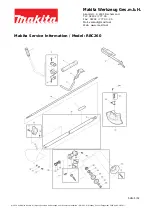
20
MILL
10.4 GIB ADJUSTMENT
The table, saddle and knee are equipped with adjustable
gibs. The gibs may require adjustment if unusual vibration
is noted when the locking mechanisms are off, or if you ex-
perience unusual vibration when spindle speed, tooth pitch
or depth of cut do not account for the vibration.
NOTE: When adjusting gibs, always start with the knee
first; adjust the saddle second, and adjust the table
last.
Adjustment of Knee Gib:
The knee gib adjustment screw (A, Figure 22) is located
under the chip wiper at the rear of the knee where it con-
tacts the column. Remove the way cover and the wiper to
expose the gib adjustment screw. Tighten the screw until a
slight drag is felt when turning the knee crank.
Adjustment of Saddle Gib:
The saddle gib adjustment screw is on the left front of the
saddle (B, Figure 22). Tighten the screw until a slight drag
is felt when turning the cross-feed crank.
Adjustment of Table Gib:
The table gib adjustment screw (C, Figure 22) is on the
left-hand side, beneath the table. Tighten the screw until
a slight drag is felt when turning the longitudinal table
cranks.
10.5 POWER FEED TRIP LEVER MECHANISM
Refer to Figure 23.
The power feed trip lever mechanism will need to be
adjusted if worn or whenever any trip lever mechanism
components are replaced.
1. Loosen the feed trip adjusting screw lock nut.
2. Loosen the adjusting screw until it is loose in the lever
and no longer contacts the bottom of the feed trip
plunger.
3. Using the coarse feed handle, move the quill to the
bottom of its travel so the quill stop contacts the
micrometer nut. Hold the quill on the stop.
4. Pull the feed handle out to engage the power feed
system.
5. Turn the feed trip adjusting screw until the power feed
disengages.
6. Tighten the feed trip adjusting screw.
7. Release the quill stop so you can engage the power
feed mechanism using the power feed trip lever.
8. Using the coarse feed handle, pull the quill stop back
into firm contact with the micrometer nut.
Note: The power feed should disengage when the quill
stop pushes on the micrometer nut. If it does not dis-
engage, repeat the adjustment steps above.
9. Engage the power feed and move the quill stop to the
top of its travel. Make sure that the reverse trip mech-
anism also disengages the power feed. If not, read-
just the mechanism until positive disengagement
occurs when the quill is at the top of its stroke.
Fig. 22
Fig. 23
Feed Trip Plunger
Lock Nut
Feed Trip Adjusting
Screw
Snap Ring
Screw (Pivot)
Feed Trip Rocker
Arm
Feed Trip Lever
Dowel Pin (pivot)
Overload
Clutch
Trip Lever
Cam Rod Sleeve
(assy.)
Cam Rod
Spring
Trip
Plunger
Bushing
Reverse Trip Ball Lever
Reverse Feed Trip
Plunger
Ball Lever
Retaining Screw
Quill Stop
Quill Stop Micro
Screw
Micrometer nut
and lock nut
A
C
C
B
Содержание ETM-949
Страница 9: ...9 ETM 949 ETM 949EVS Fig 2 ETM 949 DIMENSIONS ...
Страница 12: ...12 MILL Fig 5 Fig 4 Motor Switch ...
Страница 25: ...25 ETM 949 ETM 949EVS TABLE ASSEMBLY ETM 949 ETM 949EVS ...
Страница 48: ...48 MILL 14 0 WIRING DIAGRAM ETM 949 ...
Страница 49: ...49 ETM 949 ETM 949EVS WIRING DIAGRAM ETM 949EVS E type inverter ...
Страница 50: ...50 MILL WIRING DIAGRAM ETM 949EVS B type inverter ...
Страница 51: ...51 ETM 949 ETM 949EVS NOTES ...
Страница 52: ...52 MILL NOTES ...
















































